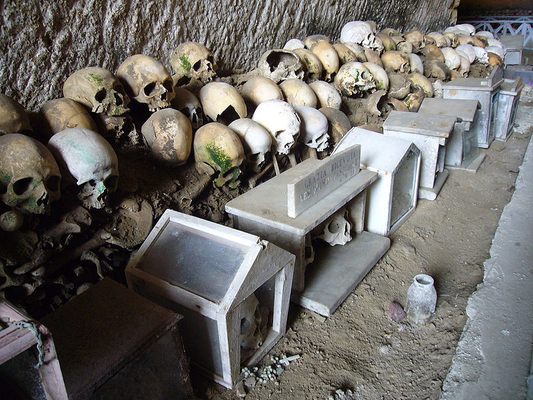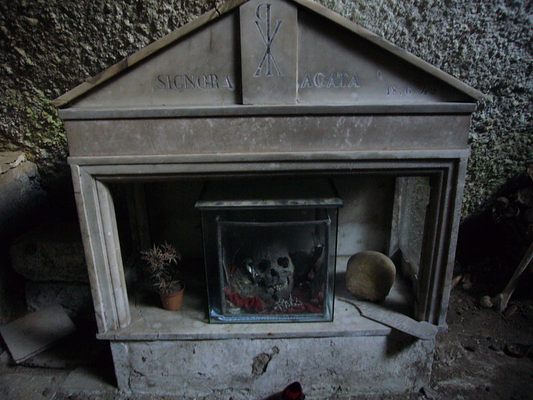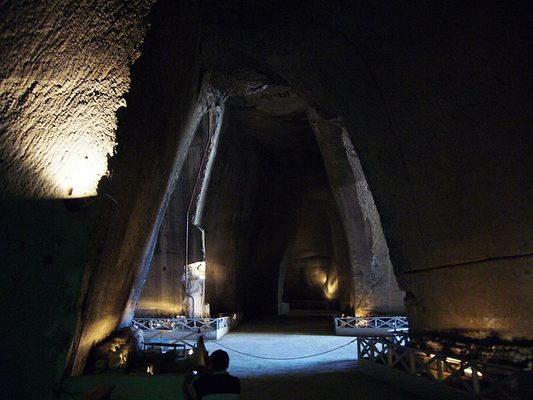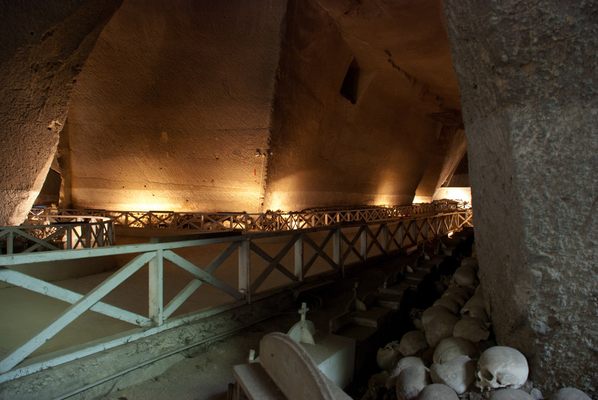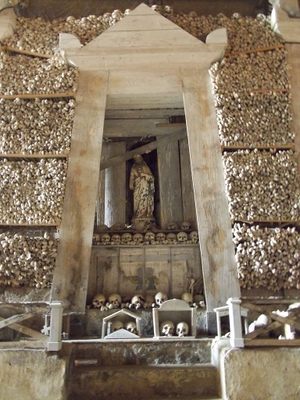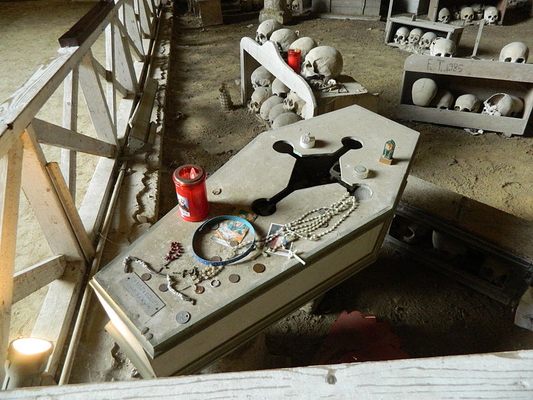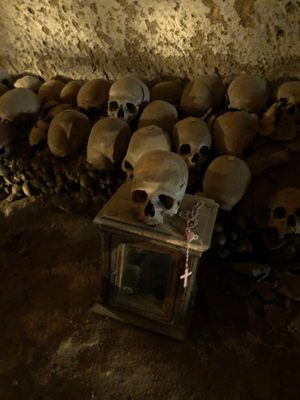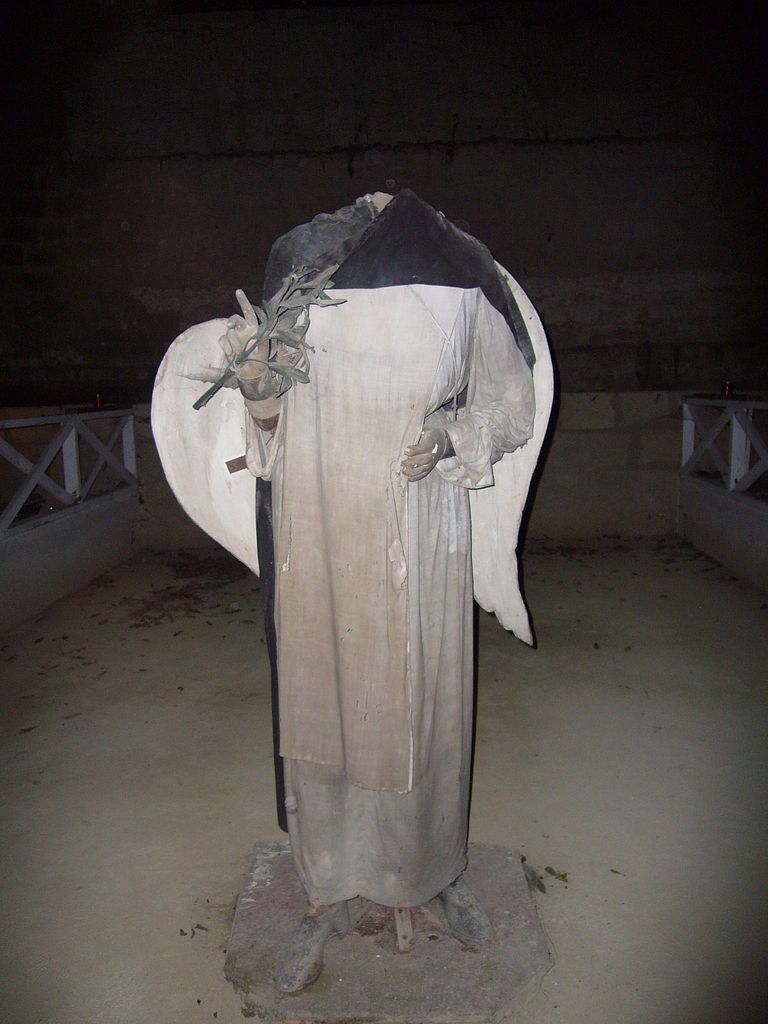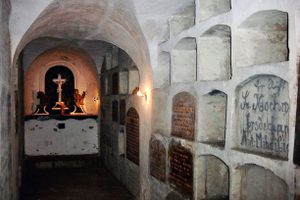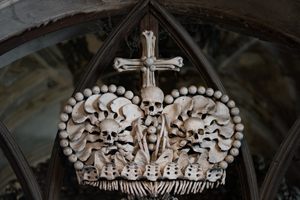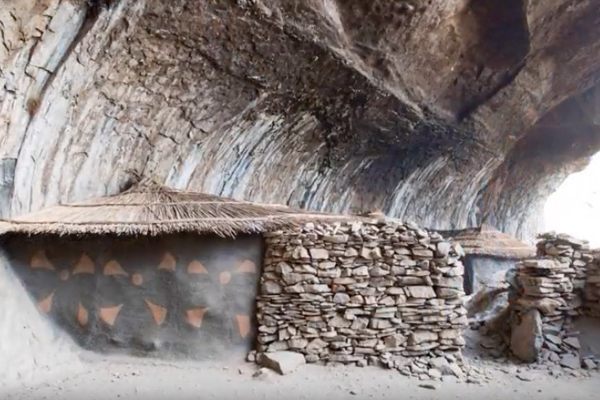About
Like many ossuaries in Europe, the Cimitero Fontanelle began as a secondary burial ground when the churchyards and crypts began to overflow. Unlike other ossuaries, the skulls of the anonymous dead were lovingly cared for, named, and then asked for prophecies of winning lotto numbers.
The offloading of temporarily buried remains into this cave on the outskirts of town began during the Spanish occupation of Naples in the 1500s, but the majority of its 40,000 residents came from the devastating plague outbreak of 1656 and smaller cholera epidemics in the 1830s.
The 1656 plague arrived in January, and by August had claimed the lives of an estimated 150,000 people, or half the population of Naples. It took generations for the city to recover from the effects of the outbreak, and the victims died and were buried (or tossed into a cave) under the most chaotic of circumstances, often without last rites, almost always without any grave marker.
In the tradition of the highly Catholic populace, these poor souls were trapped in a form of purgatory. The Fontanelle was a haunted place to be avoided at all costs, with the only exception being adding more bodies in times of outbreak. Over time, the ossuary became so crowded with haphazardly stacked bones and bodies that at one point during a heavy rainfall, the city was inundated by a flood of skulls and bones.
Starting in 1872, Father Gaetano Barbati began the enormous task of cataloging and organizing the anonymous remains. They remained unburied, but were sorted and placed on shelves and racks, in boxes or crypts. As the remains were sorted, volunteers would pray for the deceased as they worked, the beginning an unusual relationship with the dead. Long-dead anonymous skulls were given names by the women who cared for them, who would often return to chat with or ask favors from the dead, placing wishes written on papers rolled up into the empty eye sockets.
This "cult of the dead" sustained itself as a uniquely Neapolitan subculture until the bombings of World War II. Naples was the most heavily bombed city in Italy, and the Fontanelle, along with the other underground spaces in the city, served as a bomb shelter.
The Fontanelle is a combination of natural caves, tufa mines, and ancient Greek and Roman tunnels. Naples, in the shadow of Vesuvius, is located in the Campi Flegrei, or "Fiery Fields," an area of intense volcanic activity that has left the area riddled with caves, thermal springs, and craters. The early Greek residents of the area carved and quarried the soft volcanic stone, using some of the underground spaces as their own burial places. The Romans that followed dug networks of tunnels and aqueducts through the hills, often connected with the natural cave systems, all of which leaves modern Naples and the surrounding countryside riddled with underground spaces of all kinds.
Following the war, the Fontanelle cult reached its height, with women caring for and conversing with the skulls, bringing flowers and offerings, and asking for wishes to be granted. Many skulls were claimed and housed in wooden niches by individuals as personal lucky charms or fonts of prophecy—the most sought after fortune telling skill being a skull with a gift for lotto numbers. The cemetery also became a popular make-out spot as well as a late night haunt for those dabbling in a bit of black magic. In an attempt to sanctify the space, a small church, Maria Santissima del Carmine, was built near the opening to the cave, but was largely ignored.
All of this lasted until the Cardinal of Naples finally ordered the cemetery be closed to end the troubling obsession with lucky skulls in 1969. The cemetery has remained closed, with restoration efforts started again in 2000–2004 to again sort the remains as well as reinforce the structure of the cave.
After years of being off limits, it is now open by reservation.
Related Tags
Know Before You Go
Entrance is free. Guided tours of the cemetery are available, and it's best to book them in advance.
Flavors of Italy: Roman Carbonara, Florentine Steak & Venetian Cocktails
Savor local cuisine across Rome, Florence & Venice.
Book NowCommunity Contributors
Added By
Published
December 31, 2015
Sources
- http://faculty.ed.umuc.edu/~jmatthew/naples/Fontanella.htm
- http://www.redicecreations.com/article.php?id=6967
- http://faculty.ed.umuc.edu/~jmatthew/naples/blog06.html#dec9
- http://www.lonelyplanet.com/italy/campania/naples/sights/422589
- http://faculty.ed.umuc.edu/~jmatthew/naples/goldenage.htm
- http://www.firstthings.com/article/2009/07/death-in-naples
